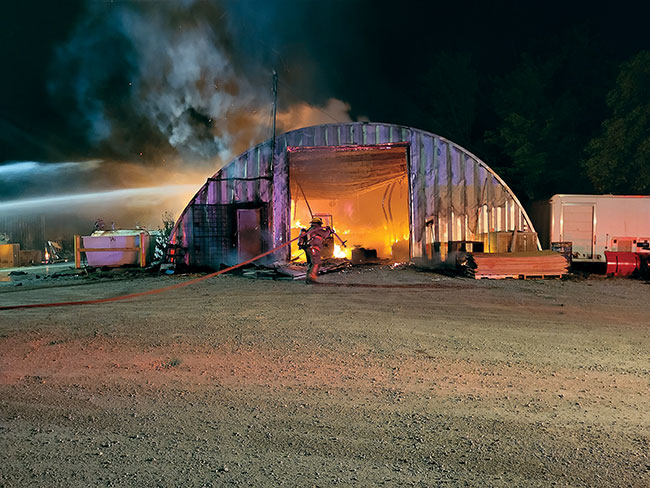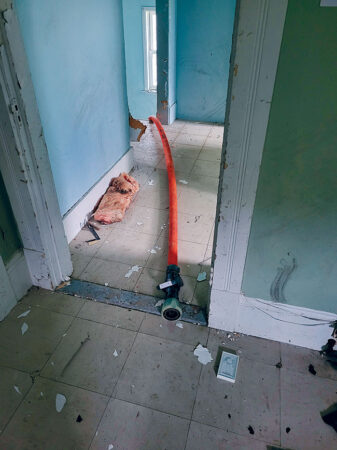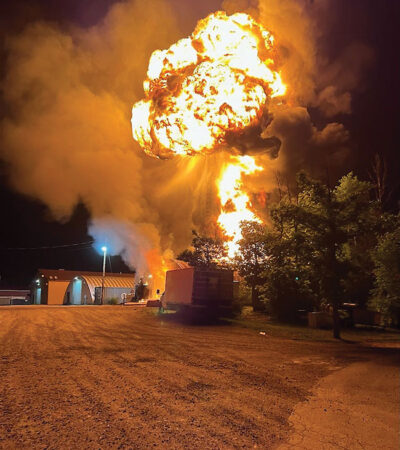
Back to basics: Desensitizing firefighters – Pulling the right size line
By Mark van der Feyst
Features Fire Ground canadian firefighter editors pick firefighter training firefighters training All defensive fires should start off with a 65 mm hose line for the attack or protection.
Photos: Mark van der Feyst
All defensive fires should start off with a 65 mm hose line for the attack or protection.
Photos: Mark van der Feyst Every fire truck will have hose lines on it either in a pre-connected fashion or as a deadline fashion. A pre-connected hose line is one that is already connected to the truck’s discharge outlet, negating the need to do so when pulling the hose line off. A deadline is the opposite – it requires you to hook up to the discharge in order to flow water.
Most fire trucks have pre-connected hose lines on the transverse beds with the deadline loads on the rear hose bed. With the transverse hose beds, a choice will be available to have two smaller hose lines and one larger hose line or just two smaller ones. A small hose line is 38 mm (1 ½”) or 45 mm (1 ¾”) in diameter and a large hose line is 65 mm (2 ½”) in diameter.

90 per cent of the time we are going to pull and advance a 45 mm and get the job done. Photo: Mark van der Feyst
With the options available to pull either a small or large size hose line, firefighters and officers need to decide on which one to pull off and advance for fire suppression activities when presented with a structure fire. This brings us to the question of 45 mm or 65 mm? (I am going to default to 45 mm for a small hose line in this article.)
Whenever we respond to a residential structure fire, 90 per cent of the time we’re going to pull and advance a 45 mm to get the job done. This is due to the quickness of the department arriving on scene, of advancing a hose line to the door and getting inside to put the fire out. It’s also based upon the fuel load that is most often found within a residential structure that will be easily suppressed with the amount of water that a 45 mm hose line can deliver.
With the high success rate of the 45 mm hose line at a residential structure fire, we seem to default to that size of hose line for every fire that we respond to, including residential structures, where perhaps a larger hose line is warranted instead. This default that we find ourselves in is where we have become desensitized.
To put some context to the smaller versus larger hose line, here are some flow rates that are common to both sizes with a smooth bore tip on the end:
- 45 mm hose line with a 7/8” tip = 160 gpm
- 45 mm hose line with a 15/16” tip = 185 gpm
- 65 mm hose line with a 1 1/8” tip = 265 gpm
- 65 mm hose line with a 1 3/16” tip = 296 gpm
With these flow rates, we can get a sense of how much water can be delivered through the hose from the truck. Remember, hose and nozzles don’t produce water, they deliver it and they will deliver whatever amount they are supplied.

The 65 mm hose line will be needed when there are advanced fire conditions on arrival. Photo: Mark van der Feyst
For a residential structure fire with a moderate fuel load, 160 to 185 gpm’s of water delivery will be sufficient to overcome the heat release rate that is produced by the fuel load. The recommended flow rate for today’s modern fires or fuel loads is 150 gpm from one hose line and it’s recommended that two hose lines be advanced for a residential structure fire with a combined flow of 300 gpm’s or 150 gpm’s each.
When we get into the heavy fuel loads of the residential structure as well as the commercial or industrial structure setting, we need to realize that bigger water will be needed to overcome the fuel load and heat release rates. Having the protection of 265 to 297 gpm’s is going to be beneficial for the initial attack team as they will have the right weaponry to overcome the high heat release rates.
Cooling of the fire box is what’s required to extinguish fire and to reduce or remove the possibility of a rapid-fire event. Water is what cools the ceiling, walls and floor of the fire box and also interrupts the chain reaction of the fire by making the fire/heat work to convert the water to steam, thus, extinguishing the fire. This work by the fire to convert the water to steam is hard work when there is lots of water being applied—if there is not enough water being applied, the fire doesn’t have to work at all and will overtake the water.
Using the acronym ADULTS, the 65 mm hose line will be needed whenever there are the following conditions present:
- Advanced fire conditions on arrival – this will include fully involved residential structures.
- Defensive fire – all defensive fires should start off with a 65 mm hose line for the attack or protection.
- Unable to determine the fire location – high heat release rates, large fuel loads, dense thick black smoke with no fire location visible yet.
- Large, uncompartmentalized areas – big open areas like a big box store.
- Tons of water needed – if there is a need for large volumes of water to be applied to the fire.
- Standpipe operations – a standpipe operation at any building requires the use of a 65 mm hose line.
Not every fire is the same and yet we treat every fire the same way due to our desensitized nature. There will be a fire coming that will require a larger hose line and the smaller one will be pulled off first, setting back the operation and possibly endangering the crew at the same time. Make sure to pull off the right sized hose line the first time.
Mark van der Feyst has been in the fire service since 1999 and is a full-time firefighter in Ontario. He teaches in Canada, the United States and India and is lead author of Residential Fire Rescue. Mark@FireStarTraining.com.
Print this page
Advertisement
- Indigenous Fire Safety Conference sparks calls for national strategy
- Two overnight fires destroy homes in Edmonton